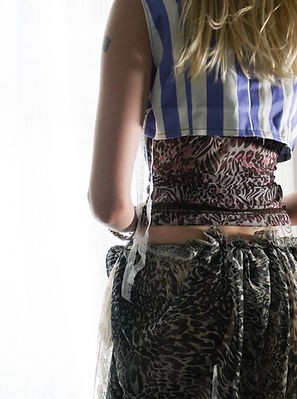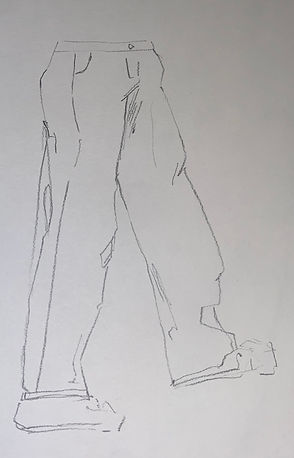
Indira Lottie Design
Through out my design journey, a value that has been at its core was sustainability, authenticity and conserving materials. Below i show examples of ice dying natural fibres and using rust- an organic dye to create bespoke, one of a kind pieces.









Once I began eduaction again, this time studying fashion- I learnt new technqiues and was exposed to further inspirations, for example Iris Van Herpen, who utilises space and structure to create pieces of art, hand made and machine made. This particularly appealed to me as to start I was reluctant to use a sewing machine, and very much preferred hand sewing. I was drawn to 90s/2000's fashion style and looked to models of that era to gain insight into the clothes I was personally interested. Loud animal prints- with a focus on hyper femininity. At this point I saw my interest moving away from nature and towards sensual clothing. When styling my photoshoots I aimed to achieve a dark-glamour aesthetic. The mix of styles and silhouettes add a mysterious atmosphere to some simple and classic design silhouettes. Using sheer materials became an interest aswell as either creating short hemlines or long, maxi designs that exaggerate the length of the female body. Looking towards Versace and designers like Gianni who viewed the female form as beautiful- and strived to create pieces of art that did not take away from that, but further enhance and highlight the beauty. 'Let your womanhood show and be proud of it'- Gianni V. As well as designers like Galliano, who worked for Margiella, who was said to have had a fascination with women and changing the narrative of sexual objectification to a sexual power. I. adopted this mind set when I begin designing my clothes, and didnt wory about things being scandalous or 'innappropriate'.
























During my education, for projects assigned my goal was to push myself structurally by using techniques and designs I wasn't confident in. For my final project, I chose the brief 'inside out', as I felt it fit my design progression perfectly. I designed a pair of bloomers- adhering to the inside out, underwear idea- including animal print suspender clips, with a low rise and short hem lines. This project took major historical inspiration of the rise of bloomers that possessed feminist values, as they provided women on the 18th century with the ability to participate in sports and other leisure activities. I styled this photoshoot to highlight the modern informality and sexuality of not caring. Again I took naughties and 2000's silhouette inspirations. For previous projects like the pinstripe top, I took inspiration from the structural integrity of circus big top tents. For this i looked into different kinds of tents and different ways I could provide the angular structure. And wanted to simulate a circus theme through the photoshoot by mixing textures and low, rich colours.
For my purple trousers I wanted to create an exaggerated length which has the ability be altered through the lace panel and purple lace ties. I used a lightweight, playful sequined textured material that hung heavy with the weight of the added lace. To achieve my desired shape i took my measurements, then compared the width and length of different trousers in charity shops, my own and friends, to find a mid point of how i wanted them to fit. If i were to make these trousers again i would increase the size at the top waistband and thighs, but keep the width of the flare the same, as well as the length.












Aswell as enthralling myself in the design process, I took an interest in structural techniques, like darts and specific tailoring. This began when I was in the process of drafting my circus top (pictured below) as well as learning bodice alterations such as slash and spread.









Having previously experimented with a range of art mediums from oil paint, acrylic paint, pencils pen and watercolour, I discovered I particularly enjoyed using oil pastels and crayons to emulate fabric. I practiced a large amount of alternate illustration styles, from stylised to autonomically correct and also ones similar to Alberto Giacometti's sculptures. I enjoy presenting my designs across a varied range of silhouettes as it helps me connect with my definitions of materials, prints and colours- or lack of. My design process includes a process of sketches in pens and crayon with potential fabric samples and methods written around, to practicing a traditional style of drawing bodies or even just textures to help me develop my skills and thought process.









































Below I used leaves and flowers to print on top to create impressions of the plants. I chose to use a blue colour pallet with pastels and metallics to create muted contrast. I also used fabric as a printing method to capture the softness and folds against the rigid lines of the plants.










The confidence I gained from learning the tailoring techniques, enabled me to create my own patterns from my measurements and using forms to drape materials. Below are the trials of creating my two waistcoat patterns.






From this-I created two waistcoats- one possessing a cheeky, feminine fit, and the other a relaxed, unisex fit. It took two trials of toilles to achieve my desired silhouette. I wanted to create the tighter fit in a thin, crepe material to further deliver a feminine atmosphere; and the looser fit one to be made out of a thicker structured material including a breast pocket, playing into the traditional clothing notion of women's and men's garments having disparities in pockets inclusion and practicality.





Returning to the textile design mentioned at the start- I designed material by hand painting with Indian ink and adding texture by using a twin needle. Something I found challenging through out my sewing journey is sourcing material I feel fit my designs. Being able to design my clothes from absolute start to finish is something I am extremely passionate about- as it also adds another layer of originality and my art work.
I experimented using the twin needle on different materials like calico, cotton and velvet in order to gain insight on how to material reacted, for future projects and garments. However I found that by introducing more thread to the fabric, the integrity and elasticity of the material is affected, therefore impacting the fit of the garment, meaning increasing the size and seam allowance is necessary.









Furthering this passion of textile design, I began using natural dyes again. Onion skins, rust dying, plants and utilising ice was something I loved doing, and have created multiple yards of different patterned material to use in my designs. With conservation and the enviroment being my driving focus within fashion- I researched the effects of dyes used and found that there are many toxic metals and chemicals, such as formaldehyde, acids and enzymes that are released into our ecosystem that collect on the surface of soils, disabling the process of photosynthesis from occuring which in turn reduces the amount of oxygen in our atmosphere. Once discovering the extent of this harmful impact I am even more determined to use deadstock material, off cuts and natural dyes where possible.
Pictured below are examples of some natural dyes I have experimented with; As well as the white, long skirt that is displayed at the top of this page, which was done using a rusted chain on linen. It is important to use natural materials as synthetic ones do not hold the dyes and can cause different reactions. The top 3 images are of black cotton that is bleach dyed once twirled from the centre into a spiral using a stick. This produced a high contrast tie dye pattern. The second two are examples and the process of rust dying on white cotton which was then treated with tea bags, using the tannins tea contains naturally. I then used this material along with the bleach dye to make a pleated mini skirt with black tulle underneath- I included photos of the process as well. For the next two photos i used brusho powdered inks, sprinkled on top of white cotton which had ice placed on top, with a wire rack underneath to allow the ink and water to fall through- disabling it from creating concentrated patterns. Despite the inks not being natural, they are non toxic and produced the most vibrant results- as expected. The last experiment I did was by using actual plants. To draw the dye out of the plants, I saturated the material with aluminium and let sit for 24 hours. With this being the most natural way to extract dyes, the sun will fade the pattern over time.















MOOD BOARDS








Universities and future aspirations.
University of the west of england- After researching universities in my area, I found that UWE provides incredible textile design facilities of knitwear, printing and your own personal studio space with access to it all week. This as well as the 18 hours of staff teaching time is very desirable to me. The opportunities to work abroad is something i have been preparing for by teaching myself Italian and studying Italian fashion. The placements offered at Iris Van Herpen, Erdem, Vivienne Westwood and Helen kirkham also interests me greatly; which is why it is my first choice of university.
Bath University- As my second choice, in order to stay in bristol- I will be applying to Bath's Fashion design course which offers a range of opportunities. Having individual work spaces, acces to embroidery machinery, digital prints and other heavy machinery. With also connections to internship placements that will be completed during the summer and also internationally. These placements and work opportunities include; McQueen, Vivienne Westwood, Tom Ford, Ted Baker, Karen Millen and Adidas.
ZOE CRAWFORD
After meeting with and listening to Zoe Crawford- a former pupil and City of Bristol, who persued a career within the fashion industry, I learned a lot about the industry. She talked us through her career timeline,which consisted of starting out as a sourcing manager- meaning she would advise her team on budgetting and sourcing of materials. She worked for multiple companies including Boden, Emma Bowan wedding dresses, Saville Rowe Tailors and Mitchell and ness. This was all after completing an Atelier course- which she described as conceptual and acheiving a high end finish to her work, enabling her to take that skill forward and bring that to the companies that employed her. She said personally that working under Boden was the best for her character and career developement, stating there was good morale, team leadership and support put in place. she also enjoyed working under the children department as it was more fun, less material and more creative- however there were more guide lines and safety regulations surrounding young childrens clothing. Having her come and speak was extremely informative and eye opening on the potential career paths and career progression you can expect within the fashion industry.
PLANNING AND FURTHER RESEARCH ON UNIVERSITIES, FASHION INFLUENCES, DESIGN OF THIS WEBSITE AND PORTFOLIO.















